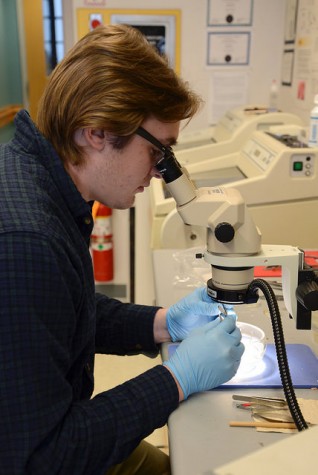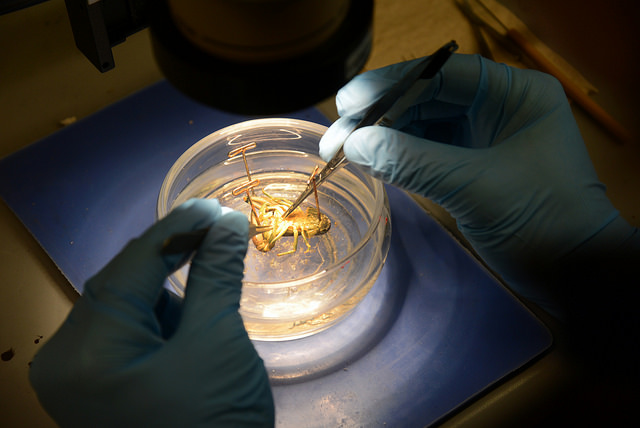Lauren French encourages neurogenesis research of crayfish
Students collaborate in hopes of reversing neurological disorders
Since the discovery that neurogenesis definitely occurs after development, French has incorporated research into her classes of the neurogenesis of crayfish in order to find out if there is a way it can relate to the human brain.
The laboratory of Dr. Lauren French, associate professor and department chair of biology at Allegheny, has a conspicuous lack of lab mice. French’s model organism of choice is a slightly less common test subject: the crayfish. Fortunately, she approaches her work with a sense of humor.
“This is the crunchy and squishy biology, as opposed to the warm and fuzzy,” she described.
What had been taken as biological gospel ten years ago is now being reexamined by Aydin Alikaya, ’15, and Gianni Vinci, ’15, two neuroscience students at Allegheny. The duo, former students and advisees of French, are exploring the process and mechanisms of neurogenesis, the growth of new brain cells, in crayfish—hence her reference to the lack of lab mice.
French herself has a background in cellular and molecular neuroscience. She now collaborates with Alikaya and Vinci as they study neurogenesis, which could someday reference a viable mechanism by which degenerative neurological disorders, such as Parkinson’s and Alzheimer’s disease, are reversed.
“The word [neurogenesis] itself refers to the production of new neurons,” French explained. “It used to be thought that this only happens during development, that when animals reach adulthood, that they’re going to have pretty much all the neurons that they’re going to have…More recently we’ve discovered that in all animals there are areas of the brain where neurons continue to be produced throughout the animal’s lifetime.”
Neurogenesis is a phenomenon that researchers now know happens after development. Identifying whether and which neurons have the potential to grow back in response to natural human hormones could yield incredible medical breakthroughs in curing or preventing a host of degenerative neurological disorders, or, by extension, instances of brain damage. In recognition of this, French already has plans to involve more biology students in the ongoing research.
“We have incorporated it in my junior seminar. Aydin and Gianna are teaching assistants, but they’re the ones running the show,” she explained. “I’m really hopeful that it’s going to take off and lead to so many different questions.”
In the seminar, Alikaya and Vinci teach the actual laboratory techniques used in their experiments to the junior participants.
This elucidation of neurological mechanisms is a cornerstone to French’s broader research interests and approaches. It is in part this uniqueness in neurons that allows Alikaya and Vinci to test whether they really are successfully making their crayfish’s brains rejuvenate neural cells.
Vinci commented, “Neurogenesis in crayfish is believed to originate from de-differentiated blood cells. Our preparation process tags the new neurons and is able to differentiate between dividing neurons and newly born ones.”
French credits Alikaya with the inception of the study. Surprisingly, the question that led to this experiment had little to do with crustaceans. He had approached French before the summer with his own question pertaining to an interest in concussions and neuroprotection in humans.
“I wanted to see if there is any way to see the inherent mechanisms of neurogenesis come into play, and to see if we could reverse the long-term effects of concussions,” Alikaya said.

Aydin Alikaya, ’15, (above) and Gianna Vinci, ’15, have become invested in the research of neurogenesis that French has begun, and are now teaching assistants in French’s junior seminar class.
Alikaya approached French with a model established by Barbara S. Beltz, Allene Lummis Russell professor in neuroscience at Wellesley College. The paper is titled “Exploring Neurogenesis in Crustaceans,” and explains how crustaceans can be used to study neurological processes in other animals. As Alikaya developed and maintained the model over the summer, Vinci caught wind of his experiment.
“My project is kind of a piggyback to Aydin’s; he is looking to see if testosterone increases neurogenesis in crayfish and I am looking to see if estrogen (specifically, 17-beta estradiol) also increases neurogenesis in crayfish,” Vinci said in an email interview. “I am hoping to compare females to males and see if there is any difference.”
According to French, studies performed on crayfish may in the future be transcribed into insights on human health.
“We think of invertebrates as simpler animals,” French explained. “Their nervous systems are different from ours in a lot of ways, but ultimately, evolution conserves what works…Ion channels and the basic operation of electrical and chemical signaling in systems is more similar than you would ever think.”
In other words, our brains are not entirely different those of the hard-shell crustaceans, at least as far as the regeneration of neurons goes. Hence, Alikaya and Vinci looked to the “crunchy and squishy” side of biology for answers.
Alikaya admits that he was taken completely by surprise when Dr. French integrated his research project and model into her junior seminar. Since the seminar began, he has enjoyed passing on his laboratory skills and knowledge to biology students, and hopes that research into neurogenesis will continue at Allegheny after he leaves.
He explained, “If I can just get one or two more people to continue in our research, I’ll feel like I’ll have contributed something to Allegheny.”







